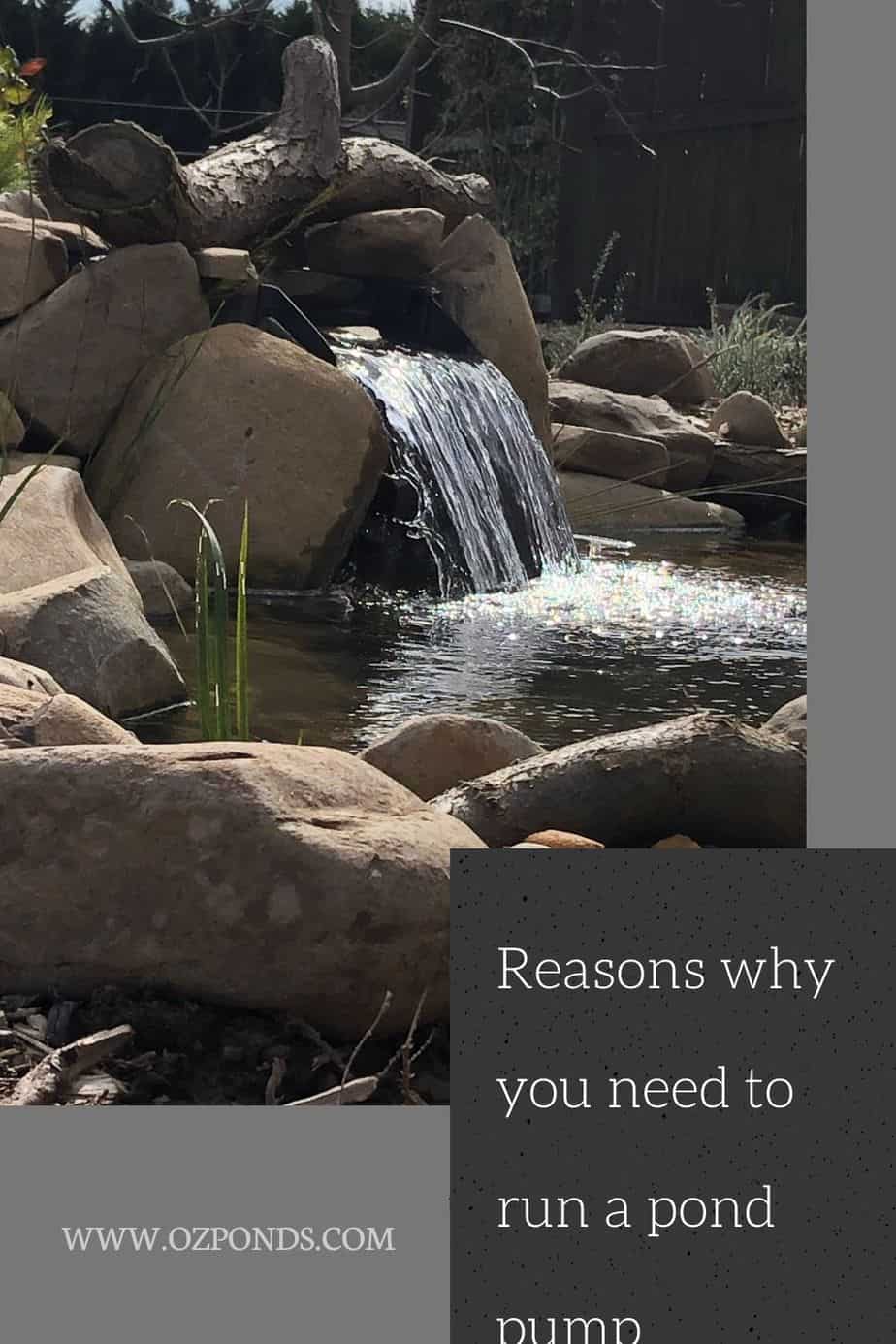Your pond pump in a fish pond should be running 24/7 that’s why it’s so important to select an energy efficient pond pump.
Running an inefficient pond pump could cost you hundred of dollars extra each year.
Ponds or water features without fish can be run on timers or turned on and off as desired.
Incorrectly sizing the pond pump can also lead to unnecessarily high power use.
For most ponds a good rule of thumb should be to circulate the pond once every hour.
If you’re unsure how much water is in your pond, you can visit my article on ‘how to calculate pond volume and surface area‘.
While circulating the pond more can sometimes be helpful it may not be necessary. Providing great filtration to the water being circulated is key!
I love a good bog filter for efficient and natural filtration. Here is a an article giving a quick overview of bog filtration.
The pump in a fish pond shouldn’t be turned off for two reasons.
Number 1 filtration and Number 2 oxygen. Both are critical to the health of the fish.
Filration
Circulation in itself is not enough. The water needs to be circulated with purpose.
Meaning the water must be filtered. For fish the most important type of filtration is biological filtration.
The water needs contact with certain bacteria’s that will purify the water.
Basically what happens is fish produce ammonia. The problem is that ammonia is very toxic to fish even in small amounts.
These bacteria, known as nitrifying bacteria will process ammonia into nitrite and then nitrate.
This process is called the nitrogen cycle. You can click the link to my article on the subject if you want to learn more. Or watch the video below.
Without the bacteria the fish will die. The good news is this process occurs naturally.
The bacteria grow on surfaces within the pond. Every surface!
So all filters that are purchased or built incorporate a biological element. Surfaces for the nitrifying bacteria to grow on.
The pump pushes, pulls or sucks the water through these surfaces. As this happens the bacteria can work their magic.
So if the pump is turned off this process becomes much less efficient.
If the pond has too many fish the ammonia can quickly build up to harmful levels.
Oxygen
Fish and the bacteria both need oxygen in the water to thrive.
Without a pump the exchange of oxygen between the air and the water is greatly reduced.
Plants will help but only during daylight hours. At night the plants will actually draw oxygen from the water.
This is very important to be aware of. Why?
Because most people who want to turn off the pond pump want to do it a night.
But this is the worst time to be turning it off.
The fish need the oxygen, the bacteria need the oxygen and now the plants need the oxygen!
Thats a lot of demand and if the pump is off…..
Not a lot of supply!
While creating a functioning ecosystem without a pond pump it is possible.
It is much harder to accomplish. If you would like to read more about a pond with no pump read this article.
Having an efficient, correctly sized pond pump working in conjunction with a filter system will go a long way to providing an easy to care for pond.
Which overtime will provide hours of enjoyment and not a lot of maintenance.
Finding an efficient pond pump
When looking at pond pumps there are plenty of numbers to look at. But here are the most important.
- Gallons or litres per hour
- Head height
- Watts
The first thing you’ll look at is how many gallons or litres the pump can move per hour. Remember we want to ensure the pond is circulated at least once every hour.
Next check the head height. This will tell you the amount of water the pump can move at different heights. This is very important if you have waterfalls or a long stream. You’ll notice as the pump moves water higher the volume of water decreases.
You need to understand this. Using the graph on the box you’ll be able to see how much water is produced at your required “head”. You can learn more about head heights in our article selecting the right pond pump.

Pond pump head height chart
Lastly we want to look at the watts. This is the amount of energy the pump is consuming every hour. Basically telling you how much it will cost you. We have a handy calculator on our cost to run a pond pump article if you want to check that out.
Now with these 3 pieces of information you’ll be able to compare all the pumps that will suit your needs and select the model with the lowest energy consumption (watts).

Pond pump maximum flow, head height and watts- usually found on the back of the box.
Circulating the water with purpose
Optimise your pond filtration
By circulating the water with purpose we can usually get away with the bare minimum, of circulating the pond every hour.
This will save us money because we don’t need a supersized pump!
It will also greatly lower the overall maintenance needed on the pond itself.
As I mentioned in the opening bringing the water into contact with beneficial bacteria is the number 1 factor for overall water health.
To do this the best way in my opinion is to run the water through a constructed wetland or bog filter.
These types of filters mimic the way nature purifies water, just in a smaller scale.
They are very low tech, easy to make and can be installed onto any size or shaped pond, formal or informal, old or new pond.
You can read how to create a bog or wetland filter by reading our article on how to build one.
Circulating the water through a wetland/bog filter provides all the biological filtration your pond will need!
It will also provide a certain amount of mechanical filtration. This is the removal of solids such as fish waste from the water.
Another form of mechanical filtration to definitely consider is adding a skimmer. A pond skimmer works by creating a current and pulling water into the skimmer box.
This gives you an easy collection point to remove things that blow into the pond like leaves.
If the leaves are allowed to sink to the bottom they begin to break down and this will release nutrients into the pond. Too many nutrients and algae will grow.
Incorporating a skimmer also provides a nice convenient location for the pond pump. In here it’s tucked away out of sight yet still very easy to access.
Having a skimmer and a wetland/ bog filter at opposite ends of your pond is the simplest and most cost effective way to move water with purpose.
How to add more oxygen
Oxygen in a pond helps maintain healthy bacteria populations, fish need oxygen to survive and good oxygen levels help disperse the build up of harmful/ smelly gasses.
Creating waterfalls, rapids or cascades as a method for the water to re-enter the pond is a fantastic cost effective way to incorporate oxygen without the need of additional equipment.
The use of specialised waterfall filters can help filter the water, add oxygen and create visual and audio appeal.
Even without a waterfall the current and ripple of a circulation pump creates oxygen exchange between the air and the waters surface.
If your existing pond pump is undersized or you purposely choose a smaller pump for economic reasons adding aerators to the pond is very cheap and easy to install.
They can deliver oxygen directly to the part of the pond that may otherwise be lacking in water movement (dead or stagnant zones).
Secondary pumps
In certain ponds it can be a good idea to have 2 or more pumps running different elements of the pond.
For example a specialised waterfall filter and a bog filter, having these dual pumps in place can be particularly effective.
Sometimes when we entertain people or when we are enjoying our ponds we desire a little more flow. Many ponds these days are incorporating streams and waterfalls.
Who doesn’t like the sound of running water, right?
To create a decent 1 foot (30cm) wide waterfall requires 1,500 gallons (5678 litres) while this is adequate sometimes we want it louder and more breathtaking visually.
If this is the case consider adding a secondary pump that is only turned on for these occasions.
This will allow you to save money on energy yet still get the full magnificence waterfalls or stream.
In some situations it may be more cost effective to run 2 energy efficient models capable of moving the desired amount of water as opposed to a single pump.
You should always weigh your options and look at the potential savings of this possibility.
Having or running multiple pumps can give you added piece of mind. Should one pump fail at least the other is still providing oxygen and some filtration.
Subscribe
If you haven’t already you probably want to sign up for my mailing list. I often receive special offers and discounts for various pond suppliers, contractors and distributors.
We love saving our readers money!
So if you want to receive these discounts go ahead and click the button below to sign up.

